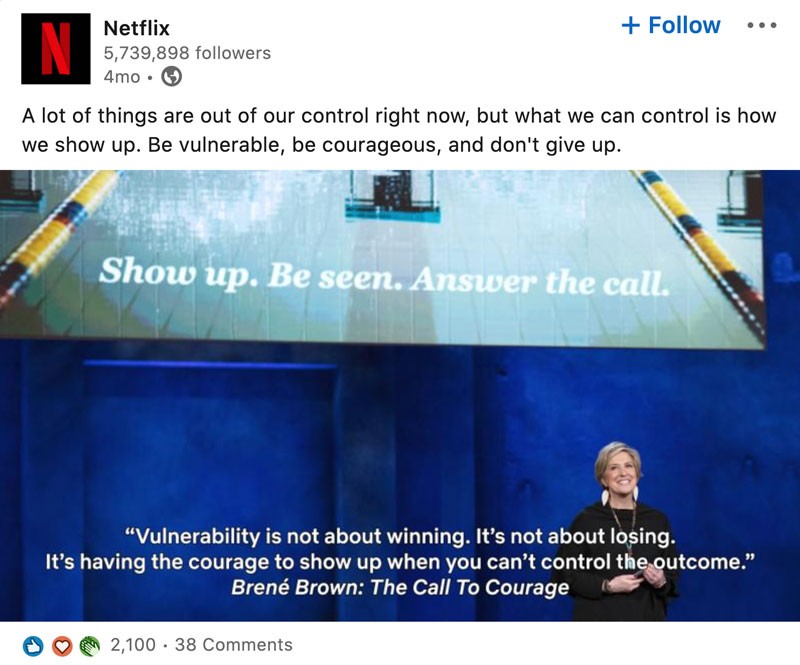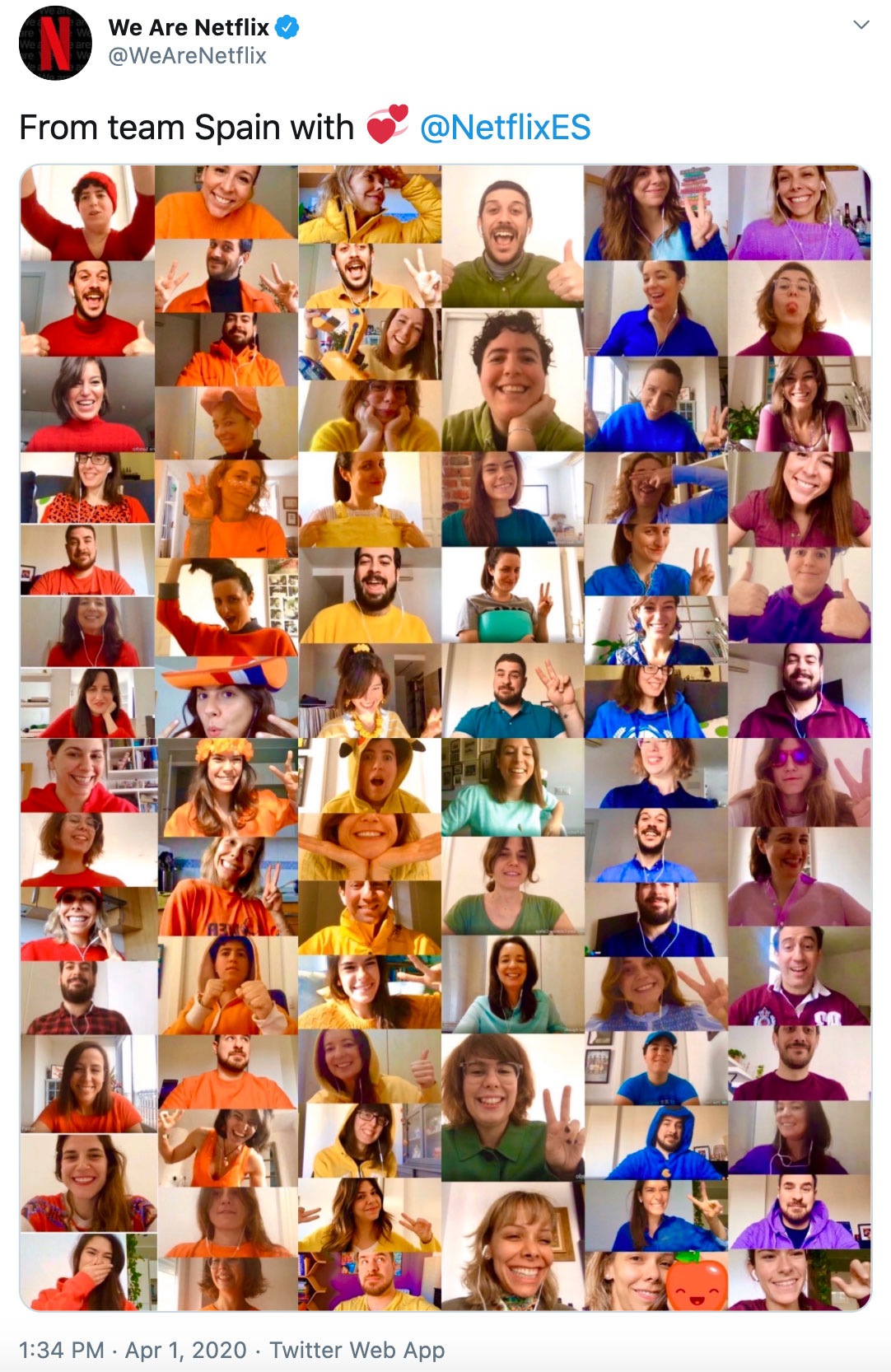
Over the past few years, Netflix has built a binge-worthy employer brand from the ground up. Known as WeAreNetflix across Twitter, Instagram, and Facebook to differentiate it from the consumer brand, and simply as Netflix on LinkedIn, the brand currently has an audience of almost six million people. And while it’s aimed at working professionals who might be interested in joining the company, as an external-facing brand, it still reflects on Netflix as a whole.
So when the world seemingly changed overnight as a result of COVID-19 and the global Black Lives Matter (BLM) protests, the employer branding team knew it would have to adjust its strategy to reflect and be sensitive to the new reality.
“It’s very important that we are aware of what’s going on in the world, in our communities,” says Marquise McCoy, program manager of employer brand at Netflix, “and that we match what’s going on in the world in an appropriate way.”
As part of the LinkedIn Impact 2020 virtual conference series, Marquise was joined by Amir Moini, Netflix’s employer branding lead, to discuss some of the steps they took to ensure they were showcasing their culture with empathy. Here are some of the key pivots they made:
1. Moving away from “edgy” branding and toward content that brings joy, inspires courage, and feels relevant
When the shift to remote work happened, Amir and Marquise quickly had to figure out how they would continue producing some of their cornerstone content, like the WeAreNetflix Podcast, in a virtual environment. But first, they had to determine if any of their planned projects needed to be rethought.
“We really had to take a step back and look at our work holistically for the year, and into 2021,” Marquise says, “and examine what projects we were going to do, which projects we were going to cancel or postpone, and which projects we were going to pick up that we wouldn’t have done before.”
The overall tone of the content also had to change. While the WeAreNetflix brand has always been highly focused on telling human stories, some of the humor might not have felt appropriate in the current climate.
“Maybe in the past, we would do more edgy things,” Amir says. “It just doesn’t feel right in this limelight. At the same time, we want to focus on more themes of courage, community, unity, authenticity, and joy — things that bring a smile to people’s faces, things that inspire and motivate them along the way.”
A recent example of this approach in action is a post the team shared featuring a screenshot from Brené Brown’s Netflix documentary The Call to Courage. In the screenshot, Brené is explaining that vulnerability is about having the courage to show up even when you can’t control the outcome.
“It can relate to a lot of situations that people are in, whether they just lost their job, or they’re feeling a little bit nervous about what’s out of their control,” Amir says. “Whatever it might be, we want to be able to give a source of comfort in their newsfeed.”
Another uplifting piece of content was born from a spontaneous decision by Netflix’s team in Spain to wear the colors of the rainbow during a video meeting.
“We thought that this would bring a smile to people’s faces,” Amir says. “It also showcases the community and joy that our team has.”
Even with this shift in direction, Amir and Marquise are dedicated to ensuring the WeAreNetflix brand remains distinct and memorable. Since a huge number of companies were posting screenshots of their teams on video calls after going remote, they had decided against going down this route — until the Spain team’s colorful meeting caught their eye.
“We thought it was unique enough to cut through the clutter,” Amir says. “You have to ask yourself, is another company doing it? And if they are, how can I do it differently so it stands out?”
This approach worked for a few weeks, bringing joy during a difficult time. But then the fatal attacks on Ahmaud Arbery, Breonna Taylor, Rayshard Brooks, and George Floyd sparked a global conversation about racial injustice that needed to be addressed.
Amir and Marquise knew that the Black community was hurting. They also knew that many Black professionals have historically felt marginalized and silenced. Recognizing that they had a significant platform that could be used to elevate Black voices, they created a video in which Netflix employees discuss what being Black means to them:
This is just one example of content Netflix has created to contribute to the Black Lives Matter conversation in a meaningful way. Another good example is a panel discussion in which Black creatives in animation discuss how to cultivate diversity and community in the future.
“It felt like the right time to encourage and continue to build the Black community in animation,” says moderator Stevi Carter, development executive of feature animation production at Netflix, in the introduction to the panel, “and honestly have a real discussion about how we’re doing and what’s going on right now.”
2. Prioritizing content that gives back, such as informative webinars
Beyond providing a source of courage, inspiration, or joy, Amir and Marquise wanted to place an emphasis on content that gives back.
“We don’t mean content that’s self-congratulatory or talking about our personal philanthropic efforts,” Amir explains. “We want to create content that gives actionable takeaways that people can apply to their own lives or company.”
A great example of this is a recent video the team produced in which the leaders of some of Netflix’s employee resource groups (ERGs) discuss the role these groups play in the organization, how they got started, and what conversations they’re having right now.
“When we look at our work and what was going on around the world, we realized that these leaders are the ones who are providing community and comfort for many of our employees,” Marquise explains. “We wanted to take our experiences and our best practices, as well as our challenges, and share them with the world so that people can use them to their advantage — whether they are starting their own ERG or they’re looking to build up an ERG even more.”
3. Focusing on quality over quantity — even if that means only posting once a month
Since they had hit the pause button on some of their planned campaigns, Amir and Marquise found they had less content than usual to work with.
They didn’t view this as a problem, however. More so than ever, they decided to focus on quality over quantity, even if this meant purposefully spacing outposts. As Amir points out, it was unlikely that anyone would be clamoring for a new Instagram post from the team with everything else going on, so it was better to wait until they had something important to say.
“Really lean into prioritizing having meaningful, engaging content,” he advises. “That way, every time you post something, it resonates with your audience in an impactful way.”
Final thoughts:
For anyone unsure how to pivot their own employer branding strategy in today’s world, Amir and Marquise have five pieces of advice:
- Focus on content that is empathetic and inspirational, without coming across as naïve or overly positive.
- Create content that is focused on giving back and helping others, but avoid anything that might seem like you’re patting yourself on the back.
- Not everything has to be about current events — people need a break sometimes, and it’s okay to give them that.
- Showcase your unique culture and your people, instead of any perks your company offers.
- Finally, keep in mind that everyone’s circumstances are different, so just because we’re all in this together, some people and communities are disproportionately impacted by the current situation. As the saying goes, “we are all in the same storm, but not in the same boat.”
“Not everybody has a work-from-home setup, let alone a job,” Amir says. “You have a wide array of people following your page and your channels, so you have to be mindful of everything you’re posting and how it resonates with each person and their different experiences.”


